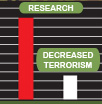This article appears on The Ethiopian-Eritrean Conflict Webpage.
The Ethiopian-Eritrean Conflict Webpage by Prof. H. Ghebre-Ab Clermont College, University of Cincinnati |
Ending Conflict Between Ethiopia and Eritrea
Practically no citizen of Africa needs to be persuaded of the benefits of preventing war and political violence. Conflict in and around any country inevitably creates turmoil and its related problems, with negative consequences. Due to the easy availability of weapons of mass destruction, future political unrest could be worse. Defending against these weapons is extremely difficult, if not impossible. Thus, war and political violence must be addressed at their root cause: collective social stress. By reducing collective social stress, Ethiopia and Eritrea could prevent war and end political violence at home and on their borders.
Mozambique was the first country to try this approach. Following decades of war, the governmental leaders, including President Joaquim Alberto Chissano, wanted an extra boost to maintain a delicate peace in 1992. Even though the UN was on the way, they decided to employ Consciousness-Based defense. The Joint Chiefs of Staff of the Armed Forces of Mozambique assigned an additional duty to several military units of Ground, Naval and Air Forces. That duty was to practice a simple mental technique.
Before implementing the technique, the Joint Chiefs of Staff carefully studied extensive research on Consciousness-Based defense. Using consciousness to prevent war was a radical idea, but Mozambique was drained from war and desperate for peace. The military units’ new duty was to practice the Transcendental Meditation program in groups twice daily. Their Commander-in-Chief, President Chissano, as well as other high-ranking leaders, practiced the Transcendental Meditation technique themselves.
The Transcendental Meditation technique is a simple, easily learned, non-religious meditation practice. Physicist and Vedic scholar Maharishi Mahesh Yogi revived the Transcendental Meditation program from India’s ancient Vedic tradition. Over 600 scientific studies have been conducted on this technique and its related programs. Transcendental Meditation has been proven to eliminate stress individually and collectively. Mozambique adopted it, and the advanced TM-Sidhi program, to prevent the return of war, improve its economy and cut the crime rate.
Soon, positive trends were observed. Crime decreased substantially. Lt. General Tobias Dai, then Commander of the Mozambique Armed Forces (now the Defense Minister), said, “When thousands of people were taught in Maputo, it was possible to assess a decrease of 20% in the crime index during the first quarter of 1993. This situation was totally anomalous, because, at the end of the war, an increase of crime would be expected.” This trend was repeated in other areas. “The same thing (crime decrease of 20%) happened in the city of Quelimane and the province of Manica,” said Dai.
As part of the peace agreement, the military began to demobilize. Groups of meditators disbanded and the positive trends reversed. Dai said, “What is very clear is that once the positive effect is created, if group practice is stopped, the previous tendencies of higher collective stress, as determined from the crime indexes and the tense situations in the country, began to rise again. In 1994, there was a remarkable decrease in coherence in the country as a result of decreased participation in the group practice of the Transcendental Meditation and TM-Sidhi Program…” New groups of meditators, although smaller, were formed.
Over the decades, Mozambique has been devastated by problems. It sought independence from Portugal in 1964. Even after independence was achieved in 1975, civil and border conflicts ensued. Massacres, drought, and famine plagued the populace.
The population often lived in a climate of fear. In 1986, armed forces from one of Mozambique’s factions were expelled from the neighboring country of Malawi. As these fighters poured into northern Mozambique, tens of thousands of Mozambican refugees flooded Malawi to escape violence. The next year, large numbers of Mozambicans were massacred. The country was brought to the verge of collapse.
Mozambique is a prime example of how fear is a driving force in the current defense paradigm. When conflict and war erupt, this fear-based model applies to factions within countries, as well as between opposing countries. As in other countries, Mozambique’s conflicts dragged on for years, inciting fear in the population. Often, unrest affects neighboring countries, spreading violence. For instance, the South African Defense Force raided Mozambique in 1981.
Fear of attack causes countries and factions to build up arms. This is a self-reinforcing cycle as other groups are drawn into the fray. While the cycle of arms build-up brings wealth to arms dealers, it drains resources that might be better spent on alleviating economic, social, and environmental problems.
Historically, peace-making and peacekeeping forces are usually ineffective at stopping civil and interstate war. The prospects of stopping a large-scale war are dim. Lt. General Dai said, “The proposed future UNO (United Nations Organization) mission…was not a guarantee of the maintenance of peace — as has been seen in many countries in the world.” Mozambique’s strong desire for permanent peace was a significant factor in their choosing Consciousness-Based defense. Mozambique was the only country to try Consciousness-Based defense in the 1900’s. It also had “the only successful UNO mission in the world,” said Dai.
Extensive research indicates that only one percent of a population practicing the TM technique results in a coherent society. Fewer practitioners of the more advanced TM-Sidhi program seem to be needed to create the same effect — just the square root of one percent of the population.
![]()
Nearly fifty studies on the social coherence-creating effects of the TM and TM-Sidhi program have been conducted in the last 25 years. Peer-reviewed publications, such as The Journal of Conflict Resolution, Social Indicators Research, Journal of Crime and Justice, Journal of Mind and Behavior, and International Journal of Neuroscience are among the respected scientific journals that have published studies. The changes include: reductions in war deaths, crime, violence, accidents, and illness; improvements in economic conditions; and enhanced quality of life.
President Chissano asserts that creating peace with Consciousness-Based defense requires a shift in consciousness. “The culture of war has to be replaced by the culture of peace,” says Chissano. “For that purpose, something deeper has to be changed in our minds and in our consciousness to prevent the recurrence of war.”
Mozambique was the first country to deploy Consciousness-Based defense in modern times. In the face of modern dangers, Ethiopia and Eritrea have the chance to put Consciousness-Based defense to the ultimate test. Mozambique has lead the first charge. Now Ethiopia and Eritrea have the opportunity to go down in history as the creators of peace for the whole of Africa.
About the Authors:
Dr. David R. Leffler received his Ph.D. on the topic of Consciousness-Based military defense. Mrs. Lee M. Leffler received her Master of Arts in Professional Writing.
Please read Major General Singh’s comments published in U.S. Medicine, a major national magazine for health professionals published in Washington, DC.
More information about Consciousness-Based defense is also available at: https://www.CenterForAdvancedMilitaryScience.org.







